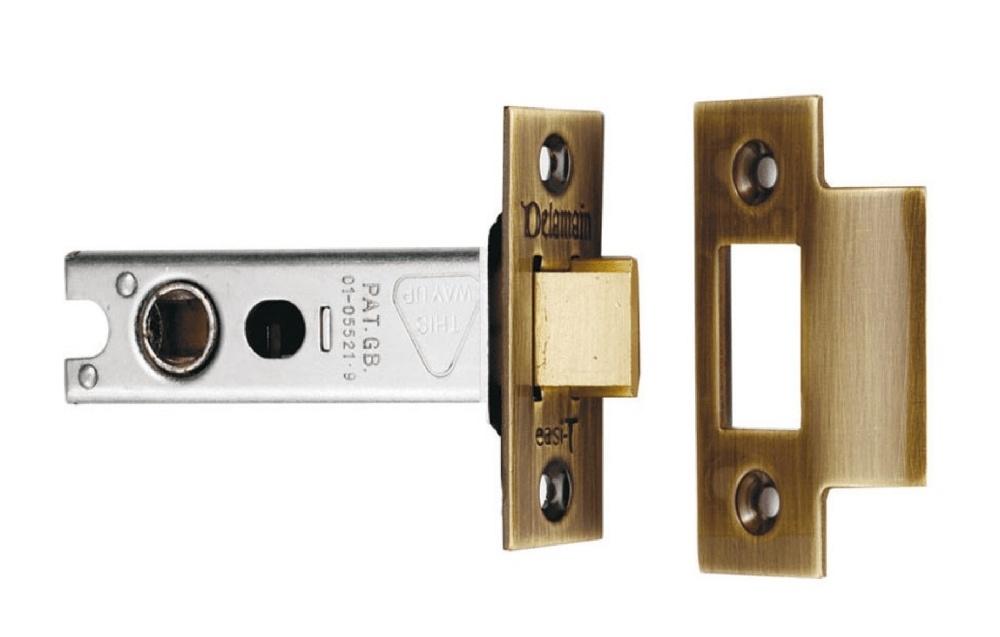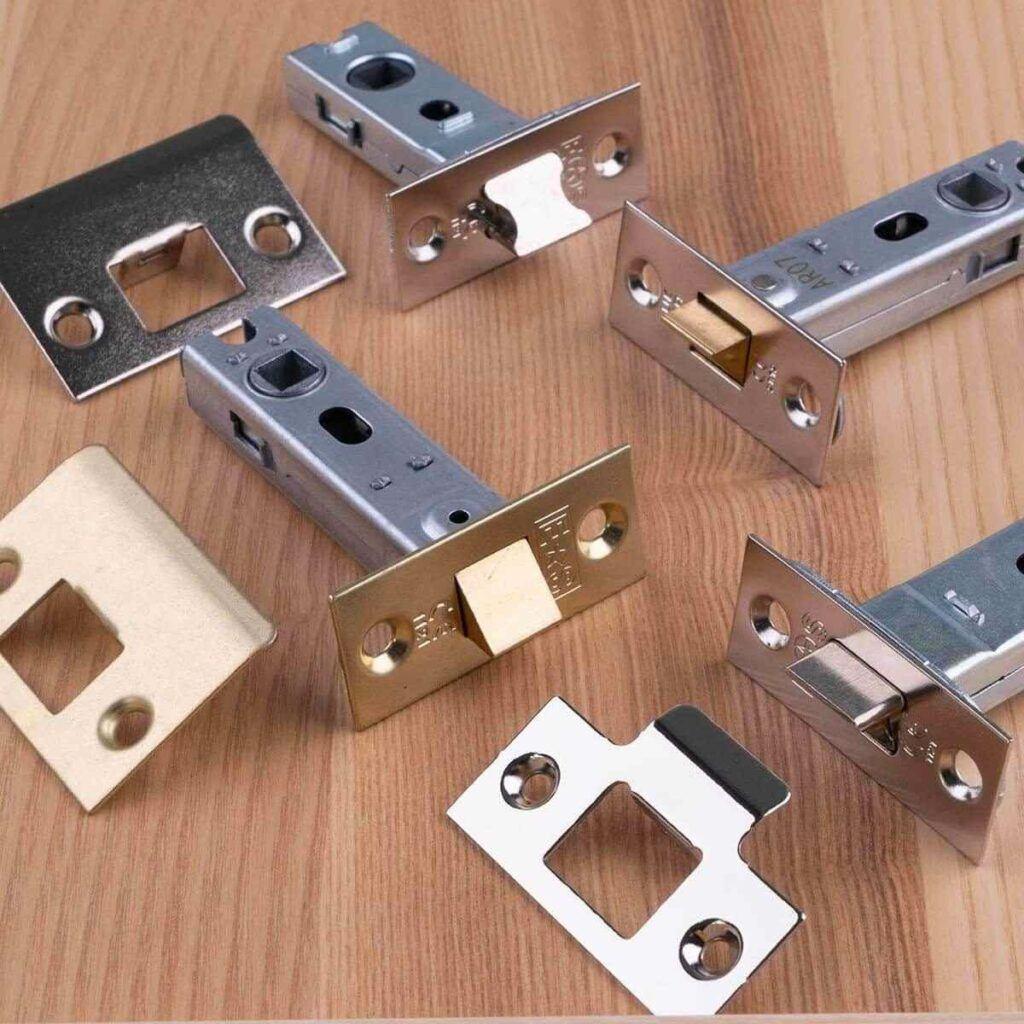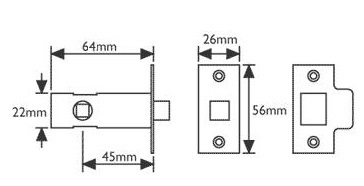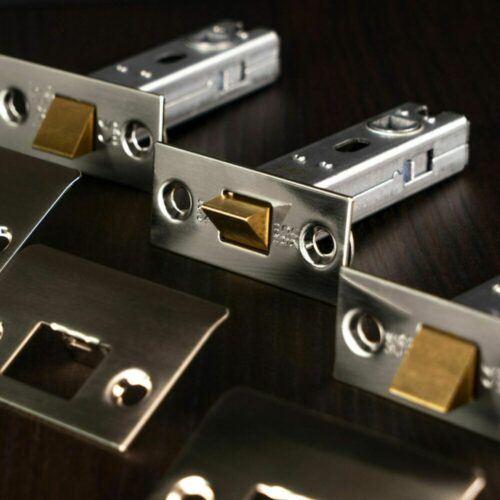A Guide To Choose The Right Tubular Latch
15 July 2023 :: How To Guides & Home Security
A Guide To Choose The Right Tubular Latch
What Is a Tubular Latch?
The Tubular Latch is a simple closing device commonly used on internal doors where no lock is needed. The Tubular Mortice Latch is an evolution from a Mortice Lock, downsized so that it can be fitted with much less effort, and with minimal drilling and cutting to the door required. This guide is to help with How to Choose the right tubular latch.

The Tubular Latch is available in various sizes and variations to suit your doors. Typically they are manufactured with a mild steel latch-body with a short faceplate, a brass or steel tongue, and an 8mm follower. (The follower is the square hole where the spindle joining the door handles passes through the latch.)
Commonly supplied with square edges to the faceplate and strikeplate, however also available with radius edges which are often preferred by the manufacturing joiners who will use a router to pre-cut the holes in the door. For us mere mortals who use a chisel then the square edges are easier!
Latch Finishes
There is a wide choice of finishes available for the forend and strikeplates meaning that the latches can be coordinated perfectly with your door handles and hinges.
The cheaper economy latches are usually either Nickel Plated or Electro Brass Plated.
The better quality latches have a range of finishes in Polished Brass, Polished Steel, Satin Steel, Florentine Bronze, Power Coat Black and more!

Latch Length & Backset sizes
How to choose the right tubular latch. The Tubular Latch Sizes come in five industry-standard lengths: 64mm, 76mm, 102mm, 127mm, and 152mm. This is the measurement of the overall length of the latch case. Each of these sizes has its own unique ‘Backset' measurement. The Backset is the distance from the faceplate of the latch, to the centre of the follower (The follower is the square hole where the spindle goes through the latch.) The size of the Backset is important because it will determine where your handle or knob sits on the face of the door. The industry standard Backset sizes are: 45mm, 56mm, 82mm, 107mm and 130mm. So the following rule generally applies:
Latch size 64mm = 45mm backset
Latch size 76mm = 57mm backset
Latch size 102mm = 82mm backset
Latch size 127mm = 107mm backset
Latch size 152mm = 130mm backset

How to measure what latch size I need
An easy way to choose which tubular latch you need is to measure from the edge of your door to the centre of your door Stile (The stile is the vertical edge section of your door). Choose the Backset which is closest to this measurement. This means your handle will be as central as possible to the Stile on your door. We generally recommend that a 76mm overall latch size is ordinarily the best size for most lever handles. However the shorter 64mm overall size should be used where the door is glazed, to minimize the risk of hitting the glass rebate when drilling to fit the latch.
The larger sizes of latch are usually used for Door Knob furniture. We would usually recommend using the 102mm (4”) Tubular Latch or larger for a door knob, but the 76mm (3”) can be used as an absolute minimum. It is best to try and set the door knob further away from the door frame, as when a door knob is fitted too close to the door frame, (such as on a 64mm, or sometimes a 76mm latch) your fingers will become trapped between the knob and frame each time you open the door, which is very inconvenient and often painful! For this reason, door knobs are often fitted into the mid-rail on panelled doors, so that a longer latch can be fitted, which will also look more traditional.
Bolt-Through Fixing Holes
Most Tubular Latches, with the exception of the Economy range, are supplied with Bolt-Through Fixing Holes. These are the holes in the latch case located on either side of the Follower. These Fixing Holes are designed to allow the fixing bolts, which are often supplied with door handles, to pass through the door and the latch mechanism so that the handles can be bolted together. The hole at the rear of the Latch is just a cutaway to the rear of the case.
Heavy and Double Sprung Tubular Latches
Choose the right tubular latch. There are several levels of quality available in a Tubular Latch, ranging from economy to high-end architectural quality. The economy and standard Tubular Latches are suitable for light use only and are commonly used by housebuilders and tradesmen. They will work with most standard sprung lever handles, however after some amount of use, they may begin to squeak and scratch, and may ultimately fail. We do not recommend the Economy or Standard Tubular Latches are used with door knobs.
We usually try and recommend the Double Sprung Tubular Latch (ZTLKA) for most applications. The Double Sprung Latch is still within an affordable price range, but is built with far superior components to the Economy latches. The term 'Double Sprung' means that the latch has a separate soft spring for the tongue action, allowing a gentle closing action to the door. The follower works on a separate spring with a heavy action, to ensure that heavy levers and unsprung door knobs are always returned to the horizontal position. It also has a wide range of sizes which make it the ideal choice for fitting door handles or knobs.
This latch comes as standard with a quality, removable Forend which acts as a guide for the Latch Tongue to improve the action. Also supplied is a Strike Plate with a black plastic Dust Box to neaten the appearance and conceal unsightly chisel marks into the door frame. The Strike Plate has a small adjustable plate that ensures that the Latch Tongue is held securely. These are only little details, but make all the difference!
The Heavy Sprung Architectural Tubular Latch is the strongest latch in our range. Again the latch closes very softly but has a more powerful spring to return the handle or knob. This is ideal when fitting handles or knobs that are unsprung, and particularly useful when using exceptionally heavy hardware, such as solid stainless steel levers or solid brass or bronze door knobs. This Tubular Latch is the highest quality latch we offer, and also comes as standard with a quality, removable Forend and Strike Plate, and a black dust box.
How To Fit A Tubular Latch
See this helpful guide from Ultimate Handyman on how to fit a latch.
NOTE: Remember to ensure that the hole drilled for the latch is large enough to allow space for the latch mechanism to operate correctly. If the hole is too narrow and the Latch only just fits inside, then the case body can be compressed and particularly the spring mechanism, which means over time the spring will fail and the latch will stop working. Make sure that the hole allows a couple of mm spare around the latch case.
If you are in any doubt when trying to choose the right tubular latch for your application, just give us a call and one of the Ironmongery Specialists at More Handles will be glad to assist in recommending the correct latch for you.

